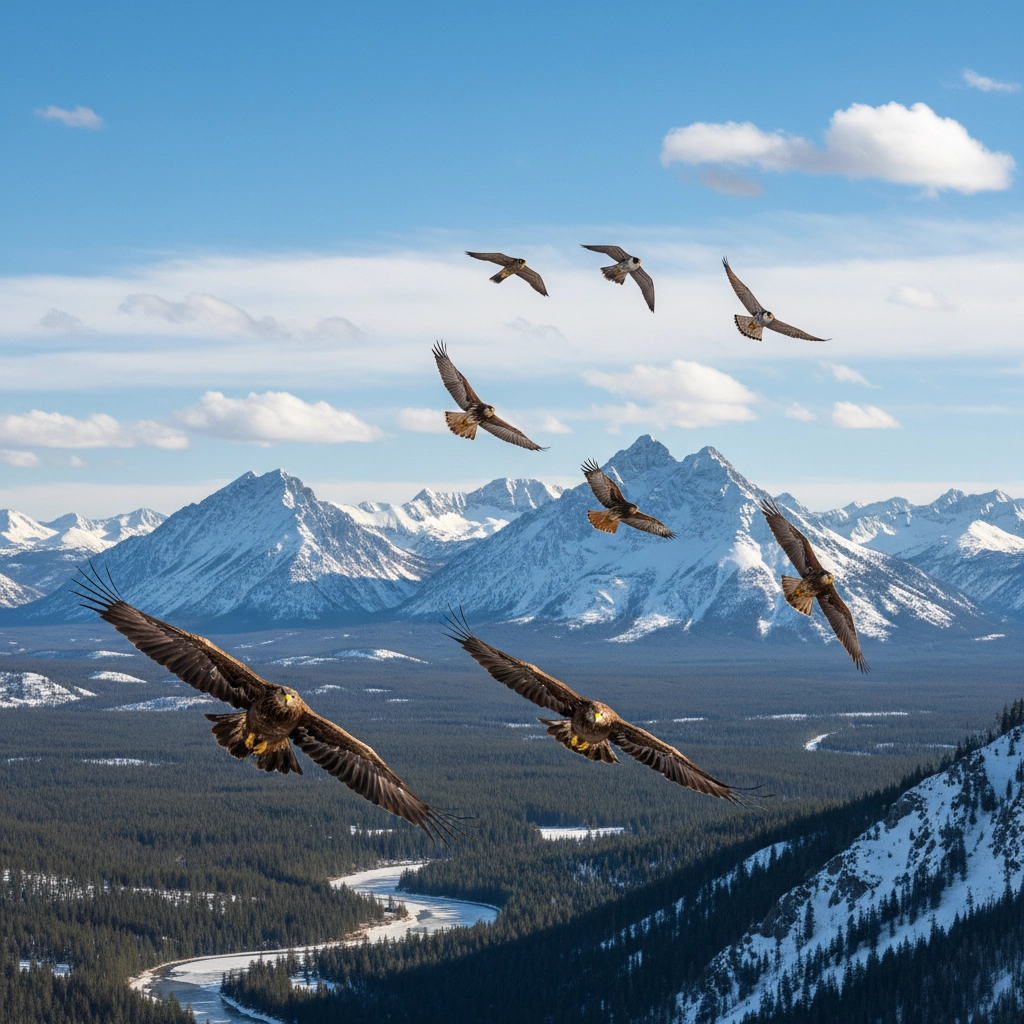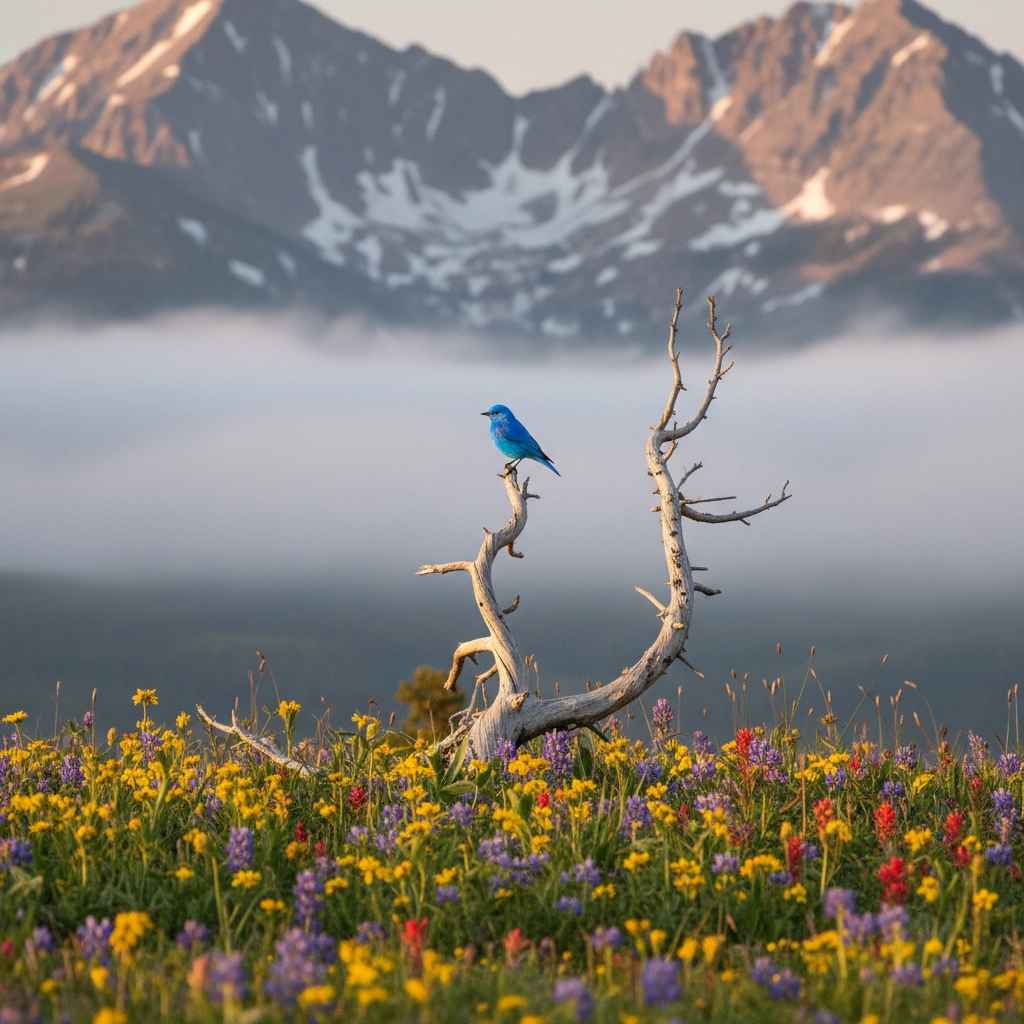Birds of Yellowstone: Migratory Patterns and Biodiversity Highlights
- Caleb Mullenix
- 8 hours ago
- 5 min read
Yellowstone National Park represents one of North America's most critical avian ecosystems, supporting extraordinary biodiversity and serving as an essential waystation along major migratory corridors. Understanding the intricate patterns of bird migration and the remarkable species diversity within this iconic landscape provides students with unparalleled opportunities to observe ecological principles in action and witness conservation science at work.
The Scale of Yellowstone's Avian Diversity
Yellowstone's bird populations demonstrate the park's ecological significance on a continental scale. Over 150 species of birds return to Yellowstone each year to establish breeding territories and raise their young, creating one of the most dynamic seasonal transformations in the North American wilderness. This remarkable diversity encompasses everything from tiny hummingbirds to massive trumpeter swans, each species filling distinct ecological niches within the park's varied habitats.
The park supports 19 breeding raptor species, establishing Yellowstone as a premier destination for observing birds of prey in their natural environment. These apex predators play crucial roles in maintaining ecosystem balance, and their presence indicates the health of the entire food web. Students studying Yellowstone's raptors gain insights into predator-prey relationships, territorial behavior, and the complex ecological interactions that sustain wilderness ecosystems.

Year-Round Residents and Seasonal Adaptations
While many of Yellowstone's birds are seasonal visitors, several hardy species remain throughout the challenging winter months. Year-round residents include the common raven, Canada goose, trumpeter swan, and dusky grouse: species that have evolved remarkable adaptations to survive in one of North America's harshest winter environments.
These permanent residents demonstrate crucial survival strategies that students can observe and document:
Behavioral adaptations: Ravens exhibit complex social behaviors and problem-solving abilities that enable winter survival
Physical adaptations: Trumpeter swans possess specialized feather structures and metabolic adjustments for cold weather endurance
Habitat utilization: Dusky grouse migrate vertically, moving from lower elevations to high-altitude coniferous forests where snow provides insulation
Understanding these adaptations provides students with concrete examples of evolutionary biology and ecological adaptation in action.
The Central Flyway: A Continental Migration Corridor
Yellowstone occupies a strategic position along the Central Flyway, one of North America's four major migration routes. This corridor channels millions of birds between their breeding and wintering grounds, creating spectacular seasonal movements that students can witness and study during properly timed educational visits.
Neotropical migratory birds undertake some of the most remarkable journeys in the animal kingdom, traveling from Mexico, Central America, and South America to reach Yellowstone's breeding habitats. Key species following this route include:
Warblers: Multiple species of these small, colorful songbirds arrive in spring after journeys exceeding 3,000 miles
Flycatchers: Insect-eating specialists that time their arrival with peak insect emergence
Tanagers: Brilliantly colored birds that demonstrate long-distance navigation abilities
Peregrine falcons: The world's fastest birds, capable of reaching speeds exceeding 240 mph during hunting dives
The timing of these migrations reflects millions of years of evolutionary fine-tuning. Songbirds synchronize their arrivals with peak insect populations in spring, ensuring adequate food resources for breeding and raising young. This precise timing demonstrates the intricate relationships between climate, phenology, and animal behavior.

Critical Stopover Habitats and Refueling Stations
Yellowstone functions as more than a breeding destination; it serves as a vital refueling station for numerous species during their epic migrations. The park's diverse topography creates distinct habitat zones that support different bird communities and provide essential resources for migrating species.
Alpine Meadows: High-elevation grasslands support species like mountain bluebirds and white-crowned sparrows during breeding season, while providing stopover habitat for species continuing to even higher latitudes.
Dense Coniferous Forests: These habitats shelter warblers, nuthatches, and various woodpecker species, providing nesting sites and abundant insect prey.
Wetlands and Riparian Corridors: Yellowstone's rivers, lakes, and marshes support waterfowl, sandhill cranes, and numerous songbird species that depend on aquatic ecosystems.
Thermal Features: The unique geothermal landscape creates specialized microhabitats that remain ice-free during winter, providing critical water sources for resident species.
Spring Migration: Optimal Timing for Educational Observations
Spring represents the premier season for observing Yellowstone's migratory phenomena, offering students unmatched opportunities to witness large-scale ecological processes. During this period, bird populations surge as species arrive from wintering grounds across the Western Hemisphere.
Educational groups planning spring visits should prepare for:
Peak arrival periods: Most neotropical migrants arrive between late April and early June
Breeding behavior observations: Students can observe courtship displays, territorial establishment, and nest construction
Species identification opportunities: Spring plumage displays facilitate bird identification and behavioral studies
Dawn chorus experiences: Early morning hours provide optimal conditions for observing and recording bird vocalizations

Research and Monitoring: Science in Action
Yellowstone's bird populations undergo continuous scientific monitoring, providing students with opportunities to understand modern conservation research methods. Scientists employ sophisticated technologies to track migration patterns and population dynamics, creating datasets that inform conservation strategies across the continent.
Current research methods include:
GPS Collar Technology: Researchers track individual birds throughout their annual cycles, revealing previously unknown migration routes and stopover sites.
Aerial Surveys: Regular population counts document breeding success and identify population trends over time.
Geolocator Studies: Miniature sensors record light levels, enabling scientists to map migration routes with unprecedented precision.
Satellite Tracking: Large species like trumpeter swans can carry satellite transmitters, providing real-time location data throughout their migrations.
Recent monitoring efforts have documented significant seasonal movements, including 376 raptors representing 16 species during a single fall migration period. These comprehensive datasets demonstrate Yellowstone's continental importance for bird conservation.
Climate Change Impacts and Conservation Challenges
Climate change poses emerging threats to Yellowstone's avian populations, disrupting migration timing and habitat availability. Rising temperatures and altered precipitation patterns affect the delicate synchronization between bird arrivals and food availability, potentially reducing breeding success and population viability.
Students studying these impacts gain insights into:
Phenological mismatches: Earlier snowmelt may trigger premature migration, creating temporal disconnects between bird arrivals and peak insect abundance
Habitat shifts: Changing temperature and precipitation patterns alter vegetation communities, affecting nesting habitat quality
Food web disruptions: Climate-driven changes in insect emergence timing can reduce food availability during critical breeding periods
Understanding these challenges prepares students to engage with contemporary conservation issues and appreciate the complexity of ecosystem management in a changing world.
Educational Value and Learning Opportunities
Yellowstone's avian diversity provides exceptional educational value for student groups studying ecology, conservation biology, and environmental science. The park's bird populations demonstrate fundamental ecological concepts while offering hands-on learning experiences that enhance classroom instruction.
Students benefit from observing migration patterns firsthand, understanding the continental scale of ecological processes, and witnessing the practical application of scientific research methods. These experiences foster appreciation for wilderness conservation while developing scientific observation skills and environmental awareness.
Ensuring student safety during birding activities requires careful preparation and adherence to park regulations. Maintain appropriate distances from all wildlife, supervise students continuously, and emphasize respect for natural habitats. These precautions maximize learning opportunities while protecting both students and the remarkable bird populations that make Yellowstone an irreplaceable educational destination.



Comments